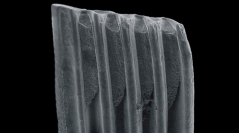

 Comptes Rendus Palevol
15 (6) - Pages 635-646
Comptes Rendus Palevol
15 (6) - Pages 635-646Unit TE9 of the Sima del Elefante (Sierra de Atapuerca, Burgos, Spain), where the remains of Homo sp. have been discovered (1.2–1.3 Ma), is also a level rich in small mammals. The taphonomic study of these small vertebrates sheds light on the landscape that provided the setting for the activities of these early hominids and allows us to describe what the cave was like during the formation of the level. Small mammal predators identified in the study indicate that during this period the Sierra de Atapuerca was part of a large biome consisting of semi-open riparian forests with meadows nearby. Postdepositional alterations reveal that the production of fossils took place outside the cave, being transported inside by water currents. During the formation of TE9, the cave presented conditions of high humidity, which made it difficult for hominids to establish occupations inside, although these conditions became somewhat less severe in TE9c, the sublevel where human remains are found.
Paleoecology, Lower Pleistocene, Taphonomy, Sima del Elefante, Small mammals, Predators